Page 227 of 376
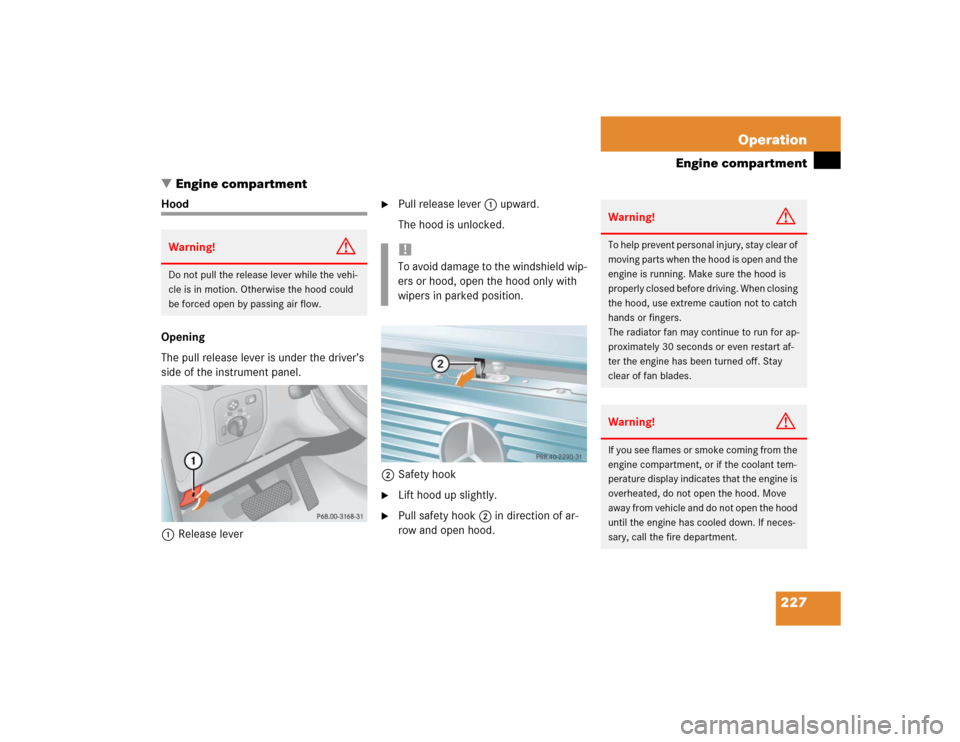
227 Operation
Engine compartment
�Engine compartment
Hood
Opening
The pull release lever is under the driver’s
side of the instrument panel.
1Release lever
�
Pull release lever1 upward.
The hood is unlocked.
2Safety hook
�
Lift hood up slightly.
�
Pull safety hook2 in direction of ar-
row and open hood.
Warning!
G
Do not pull the release lever while the vehi-
cle is in motion. Otherwise the hood could
be forced open by passing air flow.
!To avoid damage to the windshield wip-
ers or hood, open the hood only with
wipers in parked position.
Warning!
G
To help prevent personal injury, stay clear of
moving parts when the hood is open and the
engine is running. Make sure the hood is
properly closed before driving. When closing
the hood, use extreme caution not to catch
hands or fingers.
The radiator fan may continue to run for ap-
proximately 30 seconds or even restart af-
ter the engine has been turned off. Stay
clear of fan blades.Warning!
G
If you see flames or smoke coming from the
engine compartment, or if the coolant tem-
perature display indicates that the engine is
overheated, do not open the hood. Move
away from vehicle and do not open the hood
until the engine has cooled down. If neces-
sary, call the fire department.
Page 228 of 376

228 OperationEngine compartment
Closing�
Lower hood and let it drop into lock
from a height of approximately 0.7 ft
(20 cm).
The hood will lock audibly.
�
Check to make sure the hood is fully
closed.
If you can raise the hood at a point
above the headlamps, then it is not
properly closed. Open it again and let it
drop with somewhat greater force.
Engine oil
The amount of oil your engine needs will
depend on a number of factors, including
driving style. Higher oil consumption can
occur when�
the vehicle is new
�
the vehicle is driven frequently at
higher engine speeds
Engine oil consumption checks should only
be made after the vehicle break-in period.
Warning!
G
The engine is equipped with a transistorized
ignition system. Because of the high voltage,
it is dangerous to touch any components (ig-
nition coils, spark plug sockets, diagnostic
socket) of the ignition system�
with the engine running
�
while starting the engine
�
if ignition is “on” and the engine is
turned manually
Warning!
G
Be careful that you do not close the hood on
anyone.!Do not push the hood closed manually,
as this could damage it.
iDo not use any special lubricant addi-
tives, as these may damage the drive
assemblies. Using special additives not
approved by Mercedes-Benz will
restrict your warranty entitlement.
More information on this subject is
available at any Mercedes-Benz Light
Truck Center.
Page 235 of 376
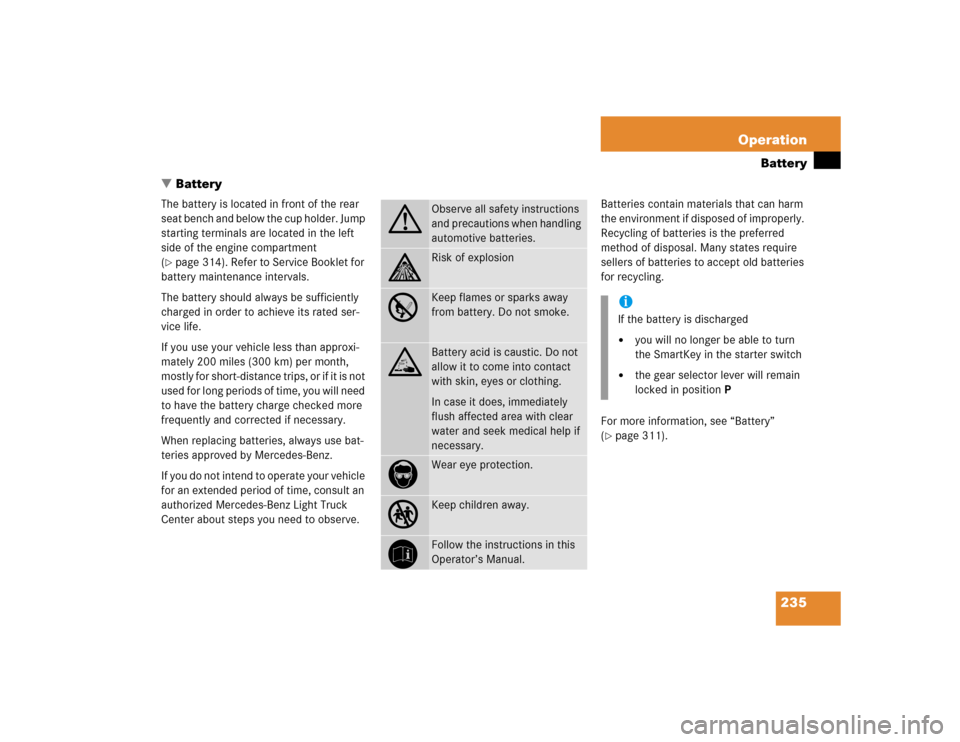
235 Operation
Battery
�Battery
The battery is located in front of the rear
seat bench and below the cup holder. Jump
starting terminals are located in the left
side of the engine compartment
(�page 314). Refer to Service Booklet for
battery maintenance intervals.
The battery should always be sufficiently
charged in order to achieve its rated ser-
vice life.
If you use your vehicle less than approxi-
mately 200 miles (300 km) per month,
mostly for short-distance trips, or if it is not
used for long periods of time, you will need
to have the battery charge checked more
frequently and corrected if necessary.
When replacing batteries, always use bat-
teries approved by Mercedes-Benz.
If you do not intend to operate your vehicle
for an extended period of time, consult an
authorized Mercedes-Benz Light Truck
Center about steps you need to observe.Batteries contain materials that can harm
the environment if disposed of improperly.
Recycling of batteries is the preferred
method of disposal. Many states require
sellers of batteries to accept old batteries
for recycling.
For more information, see “Battery”
(
�page 311).
G
Observe all safety instructions
and precautions when handling
automotive batteries.
A
Risk of explosion
D
Keep flames or sparks away
from battery. Do not smoke.
B
Battery acid is caustic. Do not
allow it to come into contact
with skin, eyes or clothing.
In case it does, immediately
flush affected area with clear
water and seek medical help if
necessary.
E
Wear eye protection.
C
Keep children away.
F
Follow the instructions in this
Operator’s Manual.
iIf the battery is discharged�
you will no longer be able to turn
the SmartKey in the starter switch
�
the gear selector lever will remain
locked in positionP
Page 240 of 376
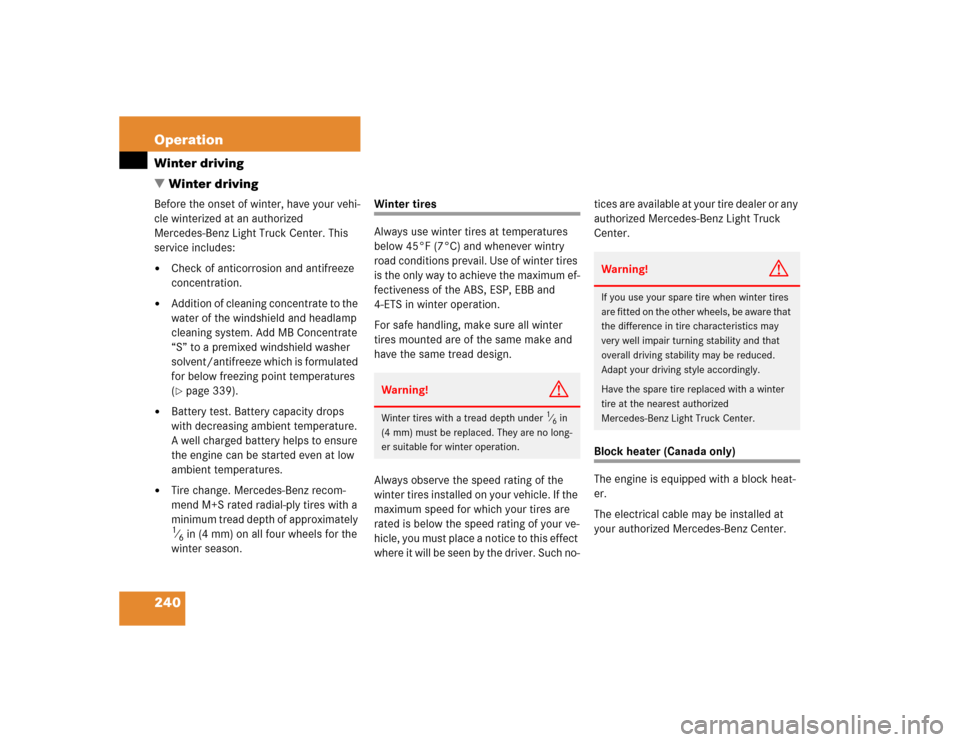
240 OperationWinter driving
�Winter drivingBefore the onset of winter, have your vehi-
cle winterized at an authorized
Mercedes-Benz Light Truck Center. This
service includes:�
Check of anticorrosion and antifreeze
concentration.
�
Addition of cleaning concentrate to the
water of the windshield and headlamp
cleaning system. Add MB Concentrate
“S” to a premixed windshield washer
solvent/antifreeze which is formulated
for below freezing point temperatures
(�page 339).
�
Battery test. Battery capacity drops
with decreasing ambient temperature.
A well charged battery helps to ensure
the engine can be started even at low
ambient temperatures.
�
Tire change. Mercedes-Benz recom-
mend M+S rated radial-ply tires with a
minimum tread depth of approximately 1⁄6in (4 mm) on all four wheels for the
winter season.
Winter tires
Always use winter tires at temperatures
below 45°F (7°C) and whenever wintry
road conditions prevail. Use of winter tires
is the only way to achieve the maximum ef-
fectiveness of the ABS, ESP, EBB and
4-ETS in winter operation.
For safe handling, make sure all winter
tires mounted are of the same make and
have the same tread design.
Always observe the speed rating of the
winter tires installed on your vehicle. If the
maximum speed for which your tires are
rated is below the speed rating of your ve-
hicle, you must place a notice to this effect
where it will be seen by the driver. Such no-tices are available at your tire dealer or any
authorized Mercedes-Benz Light Truck
Center.
Block heater (Canada only)
The engine is equipped with a block heat-
er.
The electrical cable may be installed at
your authorized Mercedes-Benz Center.
Warning!
G
Winter tires with a tread depth under
1⁄6in
(4 mm) must be replaced. They are no long-
er suitable for winter operation.
Warning!
G
If you use your spare tire when winter tires
are fitted on the other wheels, be aware that
the difference in tire characteristics may
very well impair turning stability and that
overall driving stability may be reduced.
Adapt your driving style accordingly.
Have the spare tire replaced with a winter
tire at the nearest authorized
Mercedes-Benz Light Truck Center.
Page 251 of 376
251 Practical hints
What to do if …
Where will I find ...?
Unlocking/locking in an emergency
Opening/closing in an emergency
Brush guard*
Replacing bulbs
Replacing wiper blades
Flat tire
Battery
Jump starting
Towing the vehicle
Fuses
Page 252 of 376
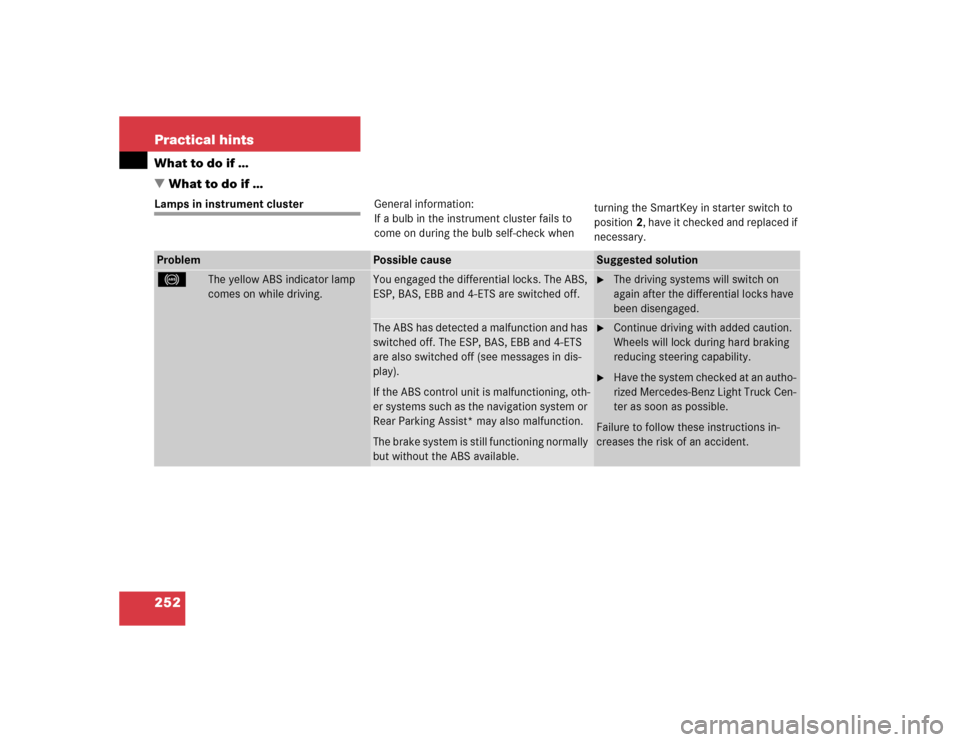
252 Practical hintsWhat to do if …
�What to do if …Lamps in instrument clusterGeneral information:
If a bulb in the instrument cluster fails to
come on during the bulb self-check when turning the SmartKey in starter switch to
position2, have it checked and replaced if
necessary.Problem
Possible cause
Suggested solution
-
The yellow ABS indicator lamp
comes on while driving.
You engaged the differential locks. The ABS,
ESP, BAS, EBB and 4-ETS are switched off.
�
The driving systems will switch on
again after the differential locks have
been disengaged.
The ABS has detected a malfunction and has
switched off. The ESP, BAS, EBB and 4-ETS
are also switched off (see messages in dis-
play).
If the ABS control unit is malfunctioning, oth-
er systems such as the navigation system or
Rear Parking Assist* may also malfunction.
The brake system is still functioning normally
but without the ABS available.
�
Continue driving with added caution.
Wheels will lock during hard braking
reducing steering capability.
�
Have the system checked at an autho-
rized Mercedes-Benz Light Truck Cen-
ter as soon as possible.
Failure to follow these instructions in-
creases the risk of an accident.
Page 256 of 376
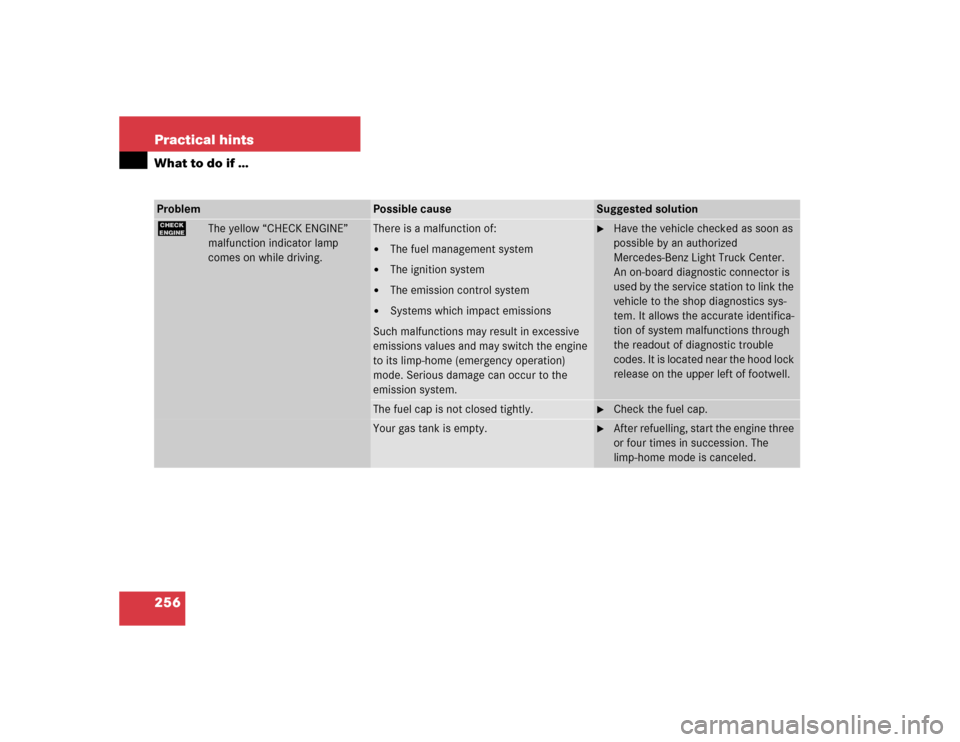
256 Practical hintsWhat to do if …Problem
Possible cause
Suggested solution
?
The yellow “CHECK ENGINE”
malfunction indicator lamp
comes on while driving.
There is a malfunction of:�
The fuel management system
�
The ignition system
�
The emission control system
�
Systems which impact emissions
Such malfunctions may result in excessive
emissions values and may switch the engine
to its limp-home (emergency operation)
mode. Serious damage can occur to the
emission system.
�
Have the vehicle checked as soon as
possible by an authorized
Mercedes-Benz Light Truck Center.
An on-board diagnostic connector is
used by the service station to link the
vehicle to the shop diagnostics sys-
tem. It allows the accurate identifica-
tion of system malfunctions through
the readout of diagnostic trouble
codes. It is located near the hood lock
release on the upper left of footwell.
The fuel cap is not closed tightly.
�
Check the fuel cap.
Your gas tank is empty.
�
After refuelling, start the engine three
or four times in succession. The
limp-home mode is canceled.
Page 257 of 376
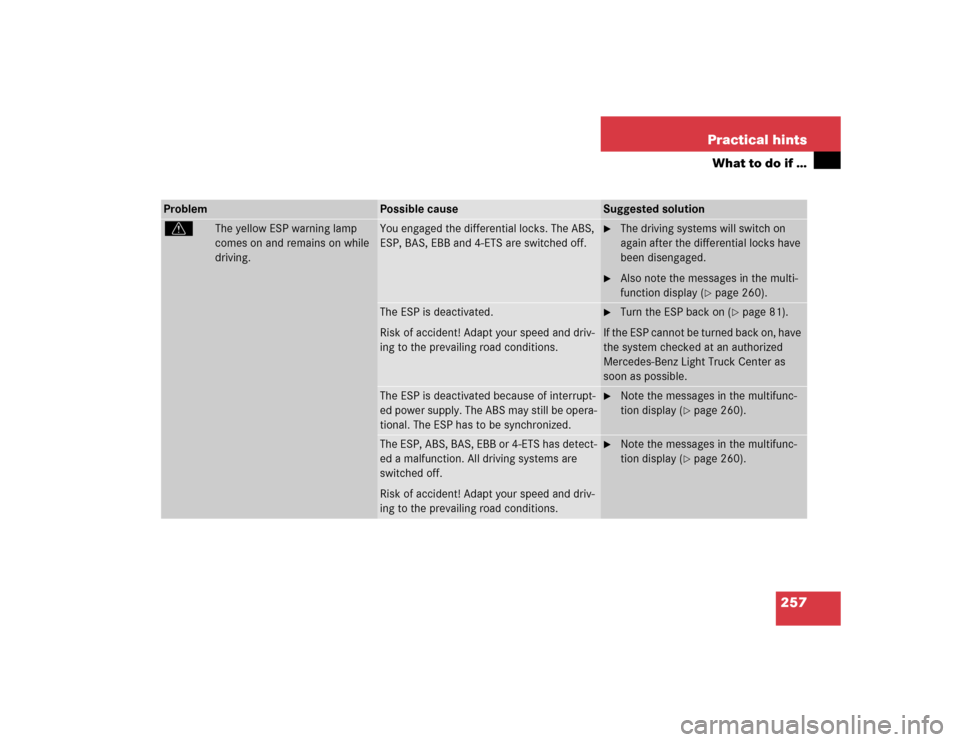
257 Practical hints
What to do if …
Problem
Possible cause
Suggested solution
v
The yellow ESP warning lamp
comes on and remains on while
driving.
You engaged the differential locks. The ABS,
ESP, BAS, EBB and 4-ETS are switched off.
�
The driving systems will switch on
again after the differential locks have
been disengaged.
�
Also note the messages in the multi-
function display (
�page 260).
The ESP is deactivated.
Risk of accident! Adapt your speed and driv-
ing to the prevailing road conditions.
�
Turn the ESP back on (
�page 81).
If the ESP cannot be turned back on, have
the system checked at an authorized
Mercedes-Benz Light Truck Center as
soon as possible.
The ESP is deactivated because of interrupt-
ed power supply. The ABS may still be opera-
tional. The ESP has to be synchronized.
�
Note the messages in the multifunc-
tion display (
�page 260).
The ESP, ABS, BAS, EBB or 4-ETS has detect-
ed a malfunction. All driving systems are
switched off.
Risk of accident! Adapt your speed and driv-
ing to the prevailing road conditions.
�
Note the messages in the multifunc-
tion display (
�page 260).